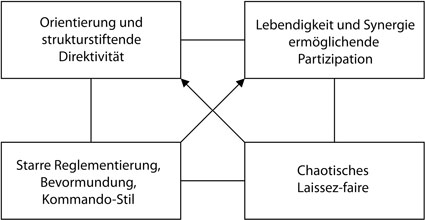Direktivität
Wer eine Leitungs- oder Führungsrolle innehat, kann diese Rolle mehr oder weniger direktiv ausüben. Direktiv heißt: lenkend, anweisend. Im Extrem beim Militär: «Rechtsum!» In den siebziger Jahren wurde das Direktive in der Pädagogik als Merkmal des Autoritären angesehen – eine nondirektive Pädagogik wollte dem Jugendlichen mehr eigenen Freiraum und mehr eigene Initiative zugestehen, da Gängelung und Bevormundung ihn zum guten Untertanten erziehen würde und ihn nicht zum selbstbewussten Teilhaber einer Demokratie werden lasse («innere Demokratisierung»). Im Zuge dieser Reformbewegung (z.B. Tausch und Tausch, 1977) wurde auch die Rolle der Führung im professionellen Kontext neu bedacht. Eine kooperative Führung verändert den Führungsstil: Aus der reinen Befehlsausgabe wird ein dialogischer Prozess. Dies verlangt der Führungskraft, die nun nicht mehr «allein das Sagen» hat, neue soziale Kompetenzen ab: Moderation von Auseinandersetzungen, empathisches Zuhören, Wertschätzung von Unterschieden. Dadurch wird die Führungs- und Leitungsrolle viel anspruchsvoller und keineswegs leichter, sodass manch einer sich nach dem alten Kommandostil zurücksehnt («und damit basta!»). Dies umso mehr, wenn das Nondirektive zu zermürbenden, nicht enden wollenden und strukturlosen Diskussionen geführt hat.
Aus kommunikationspsychologischer Sicht kommt es darauf an, Partizipation und strukturgebende Direktivität miteinander zu verbinden und in der Balance zu halten (→ Werte- und Entwicklungsquadrat, s. Abb. 16). Diese Balance wird und sollte je nach Situation (→ Situationsmodell, → Stimmigkeit) unterschiedlich ausfallen.

Direktivität im Werte- und Entwicklungsquadrat